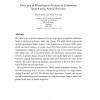Free Online Productivity Tools
i2Speak
i2Symbol
i2OCR
iTex2Img
iWeb2Print
iWeb2Shot
i2Type
iPdf2Split
iPdf2Merge
i2Bopomofo
i2Arabic
i2Style
i2Image
i2PDF
iLatex2Rtf
Sci2ools
CSL
2000
Springer
2000
Springer
Detection of phonological features in continuous speech using neural networks
We report work on the first component of a two stage speech recognition architecture based on phonological features rather than phones. The paper reports experiments on three phonological feature systems: 1) the Sound Pattern of English (SPE) system which uses binary features, 2) a multi valued (MV) feature system which uses traditional phonetic categories such as manner, place etc, and 3) Government Phonology (GP) which uses a set of structured primes. All experiments used recurrent neural networks to perform feature detection. In these networks the input layer is a standard framewise cepstral representation, and the output layer represents the values of the features. The system effectively produces a representation of the most likely phonological features for each input frame. All experiments were carried out on the TIMIT speaker independent database. The networks performed well in all cases, with the average accuracy for a single feature ranging from 86% and 93%. We describe these ...
Automated Reasoning | CSL 2000 | Phonological Feature Systems | Phonological Features | Speech Recognition |
| Added | 17 Dec 2010 |
| Updated | 17 Dec 2010 |
| Type | Journal |
| Year | 2000 |
| Where | CSL |
| Authors | Simon King, Paul Taylor |
Comments (0)

